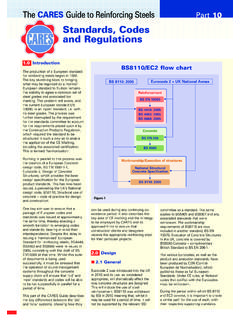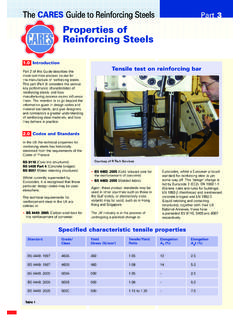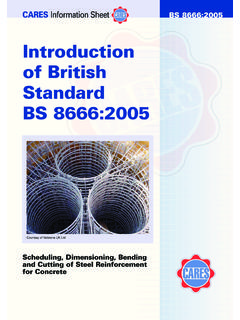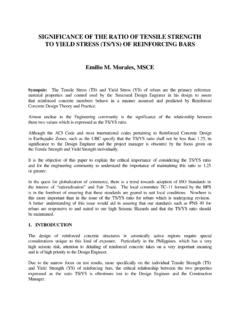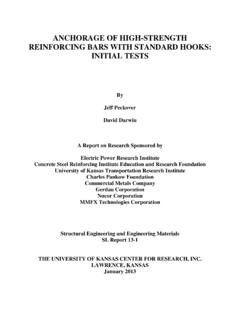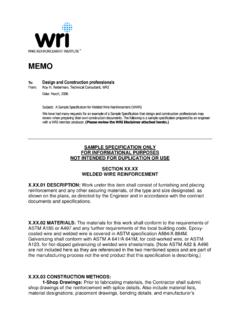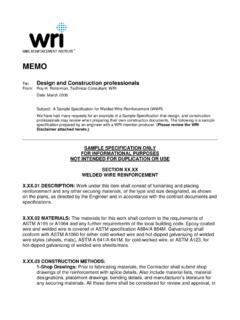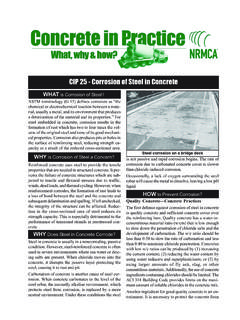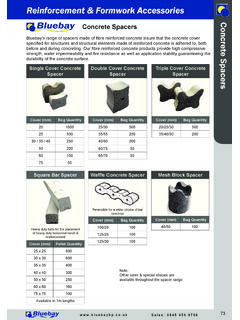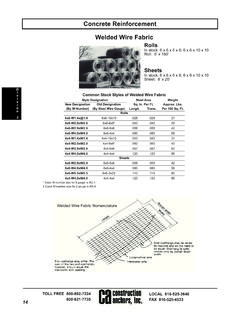Transcription of ‘melting process and type of de of the steel …
1 1 The British Standard for reinforcing steel , BS4449, clearly states that the melting process and type of de-oxidation of the steel shall be at the discretion of the steel producer . Furthermore it states that The manufacturing process for the production of coils and bars shall be at the discretion of the manufacturer . This is welcome, in that it enables an objective analysis of the final product in performance terms, without clouding the issue of compliance in process terms. It should be recognised that there is generally two main methods of producing both the steel (billet) and the final product (bar and/or coil). These will vary around the world and may be dictated by raw material availability and relative cost of manufacture.
2 It is therefore not practical to assume that the steel to be used ( in the UK) will always be made from scrap in an Electric Arc Furnace. Equally it should not be assumed that steel will be made by the quench and self temper route. The purpose of this presentation is to describe the main production processes for reinforcing steel . It may also be appreciated that, due to the demands of designers, developments in manufacturing technologies, costs of manufacture , that reinforcing steel may be regarded as a sophisticated product, requiring great care in its manufacture to ensure that the required properties are consistently met. 2 3 The feedstock materials may include iron ore, which is generally processed via a Basic Oxygen Furnace or steel scrap, which is generally processed via an Electric Arc Furnace.
3 As a rule of thumb, steel emanating from scrap is produced more frequently in Europe, whilst steel emanating from Iron Ore is more commonly manufactured in other parts of the world ( China). It is important to note that each furnace quantity is mainly referred to as a cast , that all casts are potentially different and that each cast can be approximitely 100 tonnes in weight. Sizes/quantities may vary. Most reinforcing steel , wherever it is made, tends to come via the rolling of continuously cast billets, although ingots are still used. 4 Billets, which are then rolled out to make reinforcing bars and/or coil, are generally manufactured by continuous casting. Billets may be approximately 6m long and square in cross section, measuring approximately 130mm square.
4 Sizes may vary. 5 Continuously cast billets (or less commonly ingots), usually after re-heating in a furnace, are usually rolled out via a number of rolling stands , the bars or bars in coil form becoming increasingly smaller in diameter as the stands progress. The final pass of the rolls (final stand) will dictate the final size and configeration of the reinforcing bar or bar in coil (sometimes referred to as rods). The last pass may be used t apply the ribs to the reinforcing steel , and also the dots and dashes often used to identify the certifier, country of origin and mill identity (CARES Mark). The final strength of the reinforcing bars may be achieved after the steel has passed through the final stand . 6 The final strength of reinforcing steel is often achieved by either a process of adding alloying elements (such as Vanadium) to the steel and therefore billet (ingot) or by quenching the bars/coils after they have passed through the final stand of the rolling mill.
5 The quench and self tempering process is illustrated in this slide. Bars/coils, generally after they have passed through the final stand of the rolling mill, are then fed through a mechanism of severe surface quenching via water jet/spray. The bars are then rolled out onto a cooling bed, where the heat from the centre of each bar/coil emanates outwards, via diffusion, thereby creating a tougher and stronger (annular shaped) surface. The bars/coils may therefore posses the desired properties as required by the relevant product standard. 7 This slide illustrates the possible final form of reinforcing bar/coil after rolling. This may be in bar or coil form. Coil may be subsequently decoiled and processed to a specific shape, often via a bespoke decoiling machine.
6 reinforcing Fabric may be made by processing either bars in straight lengths or made directly from coil. reinforcing steel , in bar or coil from, may start its life from Iron Ore or Scrap and be rolled out via the micro-alloying or quenching routes (there are others), but in any case, to get the final product consistently correct may take a degree of skill by the manufacturer. reinforcing steel may therefore be considered as a sophisticated product . It should be noted that the British Standard for reinforcing steel specifically forbids the re-rolling of finished product ( ship scrap or railway lines). 8 This table illustrates the difference in properties between Grade 460 Mpa steel and Grade 500 Mpa reinforcing bars as defined by the British Standard (B4449).
7 It should be noted that for steels of either strength level, each may possess a specific level of ductility, shown by the use of the identifiers A, B and C. 9 This slide illustrates that Grade B500A, Grade B500B and Grade B500B of BS4449 are allocated different transverse rib patterns, A being the top example and C being the bottom example. (BS4449 should be referred to when using steel according to this standard.) 10 11 12 This is how CARES certification is specified in prominent specifications within the UK. This slide shows the typical use of Grades of reinforcement according to its application and the specification called up. 13 The supply chain for reinforcing steel typically involves the above elements. 14 15 Processing of the reinforcement (done by companies commonly termed Fabricators in the UK) is of vital importance when giving consideration to compliance of the reinforcement as it reaches the construction site.
8 This is why CARES certificates these processors for each activity that they undertake Cutting and Bending, Coupling, Welding and/or Stocking and Distribution. The status of each certification is given on the Certificates of Approval. These should be consulted and carefully read. 16 This slide illustrates the important functions in relation to Cutting and Bending. 17 This slide illustrates the important functions in relation to Welding. 18 This slide illustrates the important functions in relation to the application of Mechanical Couplers. 19 20 If you have any questions relating to this presentation, or anything in relation to CARES, please contact CARES via the address given on the website.

